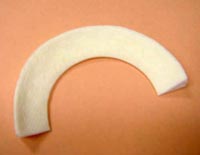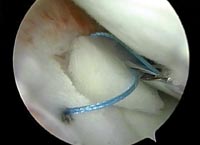The evolution of meniscal surgery: from impunity to importance
Views on the importance of the meniscus went through a sea change over the past three decades.
![Innovations in Orthopedics [icon]](/~/media/images/news/print/orthopedics-today/2005/10_october/innovations_375_60_4059.jpg) Our contemporary knowledge of the importance of the meniscus to knee anatomy and physiology seems fairly obvious. However, that knowledge and the surgical interventions that are designed to spare the structure were not always the norm.
Our contemporary knowledge of the importance of the meniscus to knee anatomy and physiology seems fairly obvious. However, that knowledge and the surgical interventions that are designed to spare the structure were not always the norm.
Surgical repair of an injured meniscus has become a common procedure in the orthopedic community. Even though the English surgeon John T. Fairbank published his findings in 1948 on the changes to the knee joint following meniscectomy, the most likely treatment an orthopedist would probably recommend prior to the 1980s was a meniscectomy. Many attribute the “resective” climate of times to the respected and influential Scottish surgeon Ian Smillie, who advocated the removal of the meniscus and developed instrumentation and techniques to make the procedure less invasive.
Didn’t realize
Courtesy of William Rodkey |
“The idea to take the meniscus completely out was not the best way to deal with it. The thinking at that time was that it gave you the best chance of fixing the problem,” said Douglas W. Jackson, MD, president of Memorial Orthopaedic Surgical Group and chief medical editor of Orthopedics Today. “But, they didn’t realize the importance of it.”
Advances in technology would soon change the way orthopedists thought about, viewed and treated the meniscus. In the late 1960s, Canadian Robert W. Jackson, MD brought the arthroscope from Japan to North America, and it didn’t take long for it to be integrated into orthopedic knee surgery. In 1971, Richard L. O’Connor, MD, introduced the operative arthroscope, which allowed surgeons to view the meniscus as never before.
One of the pioneers of orthopedic arthroscopy, Lanny Johnson, MD, now retired and living in Michigan, said surgeons initially used the arthroscope as an improved way to perform meniscectomies.
“When we started with arthroscopy, you would try to get out the whole meniscus if you could,” he said. “The thought was to separate the person from their disease. They could never have a tear in that cartilage again because it is here in this dish.”
Led astray
Jackson said that in the mid- to late 1970s, long-term data began to show that people who had meniscectomies were developing significant arthritis. In the early 1980s, basic science investigations were indicating that the meniscus provided shock-absorbing, lubricating and stabilizing properties to the knee joint.
Johnson said two of the reasons that he was led “astray” during these times were the respect he had for Smillie and earlier studies that had shown that meniscal tissue could regenerate in the canine model, and that postmeniscectomy casting could also lead to meniscal regeneration in people. These findings would be disproved when better imaging techniques indicated the fibrous tissue that generated in the meniscal void was not viable cartilage.
Johnson said that some of the things that brought him to believe in meniscal sparing was the basic science coming out of the laboratories and the results of surgeons like Kenneth E. DeHaven, MD, of the University of Rochester, N.Y., and John McGinty, MD, of Mobile, Ala., fomer chief medical editor of Orthopedics Today, whose advances with partial meniscectomies were showing long-term improvement over total removal of the meniscus.
Jackson also noted the contributions of surgeons such as W. Dilworth Cannon, MD, of San Francisco, and the late Charles Henning, MD, who developed new repair techniques.
“I think the decade of the ‘80s was the time when most of the current basic science was done,” said Steven P. Arnoczky, DVM, of the College of Veterinary Medicine at Michigan State University. His work, on the blood supply to the meniscus, co-authored by Russell F. Warren, MD, of the Hospital for Special Surgery in New York, led many orthopedists to believe that repairs to the structure could be possible.
Spurred by the work of Donald King, MD, of Oklahoma, in the 1930s on the possibility of healing the meniscus and DeHaven’s experiences with repair, they investigated the blood supply to the adult meniscus. They were able to describe and define the extent of the blood supply to both the medial and lateral meniscus, as well as its limitations.
“That, coupled with some experimental lab studies to show how that blood supply supported the healing response, gave the biologic rationale for the fact that the meniscus could, in fact, be repaired,” Arnoczky said.
He also cited the work of Abdul M. Ahmed, an engineer from Montreal, as adding to the proof that the meniscus acted as more than just a spacer in the knee. Suddenly, the basic scientists were providing the rationale and the support for what clinicians thought what was happening with the meniscus. “I think that the clinicians were 90% to 95% correct in what they thought was going on with the meniscus, in terms of their realization of how important it was,” he said. “Through the basic science studies of Ahmed, our lab, and others we showed that they were right and to provide the rationale for repairing these structures.”
Instrumental changes
Along with the knowledge that was now backed by basic science, new instrumentation made meniscal repair possible for more surgeons. Advancements that fine-tuned and augmented the arthroscope were becoming more widely used, albeit to the dismay of the established orthopedic community. “They asked, ‘Why look through a keyhole when you can just open the door?’” Johnson said of the sports medicine leadership of the time.
Jackson called Johnson’s introduction of motorized arthroscopic instruments “a step forward,” as well as the creation of zoned cannulae. Johnson said one of the most important aspects of arthroscopy at that time was the ability to perform opportunistic second looks and prove the worth of meniscal-sparing techniques.
|
“Most of us had videotapes of an initial procedure and then videos of any follow-ups, so we had very compelling data,” Johnson said. “I also had to opportunity to biopsy a few of them and I put them in my textbook. This played a huge role in our ability to provide documentation and give compelling evidence that all this made sense.”
Positive feedback
These refinements in arthroscopy not only made meniscal repair more attractive and replicable for surgeons, but they also reinforced and encouraged the basic scientists with their research.
“The advent of arthroscopy sharpened our focus,” Arnoczky said. “It gave us good positive feedback. I talked a lot with the late Chuck Henning, and we discussed new repair techniques. He would then try them clinically and send me back these arthroscopic images that were exactly what we saw in the lab. It allowed us to go from bench to bedside rather quickly.
“We do this stuff on lab animals and we wonder is this the truth, is it really the truth? The road went both ways. With what we saw in the laboratory, people had enough faith in it to try in their clinical practice. Then they came back and told us it happened the same way, and then we felt confident in the model and we were able to extend it to ideas such as the fibrin clot.”
Road to replacement
Advancements into the 1990s included work with allograft meniscal transplants, improved imaging and better arthroscopic techniques. “Meniscus repair took a major step forward with the advent of the all-inside repair techniques,” said William Rodkey, DVM, of the Steadman-Hawkins Research Foundation in Vail, Colo. “The all-inside devices have generally led to more repairs, done significantly faster, and with a tendency for less morbidity. While these all-inside devices are not perfect and can have some complications, they are very useful.”
Since the knowledge of the importance of the meniscus was understood in the last decade, the idea of meniscal transplants became highlighted, especially in the younger patients who risked a life-long ordeal with arthritis if their menscii were removed.
Rodkey said that although the idea of replacing the meniscus with allograft material has been around since the 1980s, the clinical results of meniscal allografts seem to be on the upswing. “But, there is still a great deal of development in this area that needs to be done.”
Imaging had come a long way, Jackson said. “It changed how we look at the meniscus,” he said. Since they don’t show up on regular radiographs, merely assessing the state of the meniscus was difficult prior to the development of the arthrogram, which used a contrast dye injected into the knee. Later, advances in MRI technology have made it the standard for meniscal assessment.
Rodkey said the future of meniscal treatments includes implants, biologics and new technologies. “It is likely that in the future there will be a type of adhesive that will permit the torn meniscus to be ‘glued’ back together,” he said. “Various efforts at ‘welding’ torn menisci have been attempted, but at present that seems rather far away from being clinically practical.”
He is involved with the development of a biologic collagen meniscal implant, so it is not surprising that he sees those in the future as well. “I feel that the real future of meniscus surgery and preservation lies in the use of biologic scaffolds to support the growth of new meniscus-like tissue.” Rodkey said his experience with the collagen implant indicates that the new tissue appears to function like native meniscus by permitting patients to return to a higher level of activity.
Overall, the past 30 years has seen a sea change in the role of the meniscus, which has been governed by the “three Rs”: resection, repair and restoration. Today’s investigators seem to be adding a fourth R to the doctrine: replacement.


